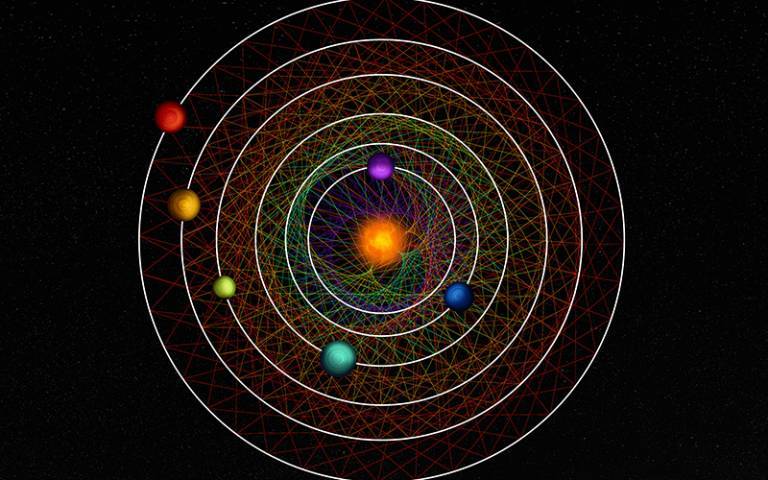Six planets in synchronised ‘dance’ lasting a billion years
29 November 2023
An international collaboration involving UCL researchers has discovered six planets orbiting their central star in a rhythmic beat, a rare case of an “in sync” gravitational lockstep that could offer deep insight into planet formation and evolution.

The findings, published in Nature, are particularly valuable as the planets are likely to have been performing this same rhythmic dance ever since the system formed more than a billion years ago.
This means the system has not suffered the smash-ups, collisions and mergers that astronomers typically expect in the early days of planet formation, as planets jockey for position.
While multi-planet systems are common in our galaxy, those in a tight gravitational formation known as “resonance” are observed by astronomers far less often. In this case, the planet closest to the star makes three orbits for every two of the next planet out – called a 3/2 resonance – a pattern that is repeated among the four closest planets.
Among the outermost planets, a pattern of four orbits for every three of the next planet out (a 4/3 resonance) is repeated twice.
Hannah Osborne, a PhD student at UCL’s Mullard Space Science Laboratory and a co-author of the study, said: “What is really amazing about this discovery is the process used to find these six planets. Initially, two possible candidates were found with TESS and then later targeted observations with Cheops revealed a third planet and confirmed the first two (although at different orbital periods than originally thought).
“But some of the transit signatures were still unaccounted for, so by analysing the period ratio of the planets already found, it was possible to predict that another three planets must exist within the system in order to account for the extra signals.
“Incredibly, when we searched for these three hidden planets we actually found them, at exactly the orbital periods that were predicted.
“The system itself is a key discovery for exoplanet science: because all six planets are in a resonant chain we know that the architecture of the system can’t have changed much since its formation, so by studying HD 110067 we get a rare window into the past to understand how these types of systems may have formed and evolved.”
Dr Luque said: “We think only about 1% of all systems stay in resonance. [This study] shows us the pristine configuration of a planetary system that has survived untouched.”
UCL’s Hannah Osborne, Dr Ed Bryant, Dr Vincent Van Eylen and PhD student Ahlam Alqasim (all Mullard Space Science Laboratory at UCL) all contributed to ground-based data gathering and analysis that helped determine the planet masses and sizes.
HD110067 is the brightest known system with four or more planets. Since those planets are all sub-Neptune-sized with atmospheres that are likely extended, it makes them ideal candidates for studying the composition of their atmospheres using the NASA-led James Webb Space Telescope and ESA’s future Ariel and Plato telescopes.
Osborne said: “Since these planets orbit such a bright star it means that we can make use of ground-based telescopes as well as space-based ones like JWST and Ariel. By combining these observing techniques, we will be able to investigate the composition and internal structure of these small planets.”
Links
- The paper in Nature
- ESA story
- Mullard Space Science Laboratory at UCL
- UCL Mathematical & Physical Sciences
Source
Image
- Credit: Thibaut Roger/NCCR PlanetS, CC BY-NC-SA 4.0 Caption: Tracing a link between two neighbour planet at regular time interval along their orbits, creates a pattern unique to each couple. The six planets of the HD110067 system create together a mesmerising geometric pattern due to their resonance-chain.
Video
- Credit: Animation & music by Dr Hugh Osborn (University of Bern). Caption: Animation of the orbits of the six planets around HD110067. The orbits and planetary sizes are to-scale relative to each other (although not relative to the size of the star). The yellow band indicates the transit region where we are able to observe the planets passing in front of HD110067. The pitch of the notes played when each planet transits matches the resonant change in orbital frequencies between each subsequent planet.
Media contact
Mark Greaves
m.greaves [at] ucl.ac.uk
 Close
Close

